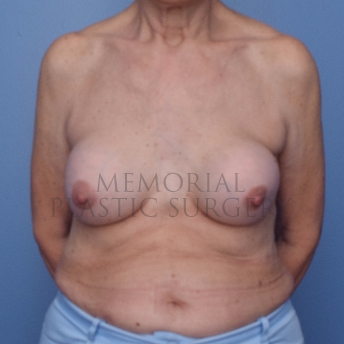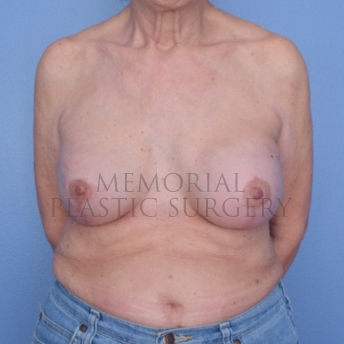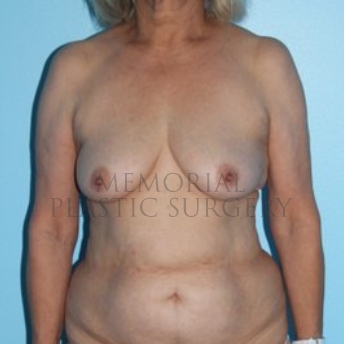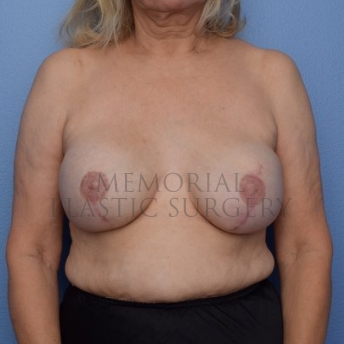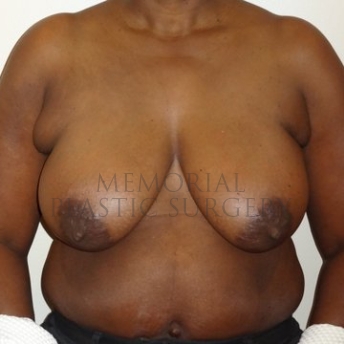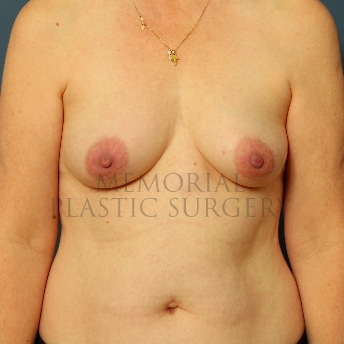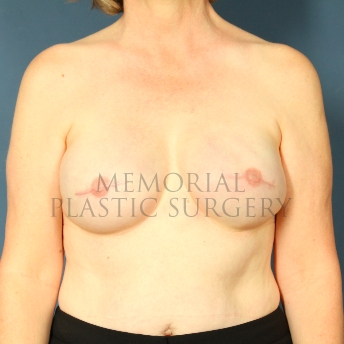BREAST RECONSTRUCTION WITH IMPLANTS IN HOUSTON & WEBSTER, TX

Implant-based reconstruction uses a saline or silicone breast implant to restore the breast after a mastectomy. It is one of many types of breast reconstruction procedures aimed to help women feel whole again.
Board-certified plastic and reconstructive surgeons Dr. Patrick Hsu, Dr. Kendall Roehl, and Dr. Vasileios Vasilakis at Memorial Plastic Surgery have successfully performed hundreds of Breast Implant Reconstruction procedures every year to give patients a boost of self-confidence.
Is Implant Reconstruction Right for Me?
Reconstruction using breast implants may be a good option for thin women since these patients do not typically have enough excess tissue required for a tissue flap reconstruction. Depending on the patient’s treatment plan, the implant may be placed immediately at the time of the mastectomy.
However, most patients need to have a temporary implant placed into the empty pocket space after a mastectomy, known as the tissue expander. The expander serves as a temporary saline implant to gradually stretch the overlying skin and muscle until the permanent implant is inserted.
Types of Breast Implants
Breast implants come in many shapes and sizes. The type of implant used in your breast reconstruction will be determined during your consultation.
Types of Implants:
- Silicone Implants
These implants are made from a soft silicone shell filled with silicone gel, which enhances the natural look and feel of the breast. Patients who wish to have immediate reconstruction may prefer this type of implant. - Saline Implants
These implants also have an outer silicone shell but are filled with sterile saline water. Saline implants do not have as much of a natural feel compared to silicone implants but are much easier to detect for ruptures.
Regardless of the type of implant used, they do not last a lifetime and will need to be replaced at around 10 years, or as recommended by your surgeon.
How is Breast Implant Reconstruction Performed?
Breast implant reconstruction procedures are performed under general anesthesia. The length of surgery time and the number of procedures needed to complete your reconstruction will vary depending on whether you are having an immediate or delayed reconstruction.
Immediate, direct-to-implant reconstruction can be performed if there is enough tissue available to cover the implant after your breast surgeon removes the breast tissue. In this case, your plastic surgeon can directly place the breast implant either under or over the chest muscle immediately following the mastectomy.
In a staged, delayed-immediate reconstruction, a tissue expander is placed between the skin and chest muscle by your plastic surgeon immediately following the mastectomy. Over a few months, the tissue expander will be filled with sterile saline solution through a valve or port to gradually stretch the skin. Once the overlying skin and muscle reach the desired size, your plastic surgeon will perform a second surgery to remove the tissue expander and replace it with a permanent breast implant.
Once permanent implants are in place, some patients may opt to have additional procedures to improve their results such as fat grafting to the breast for a smoother contour, or a nipple and/or areola reconstruction if a nipple-sparing mastectomy was unable to be performed.
Recovery and Results
Your recovery period after breast implant reconstruction will vary, depending on the type of reconstruction surgery performed. Immediate reconstruction will typically have a recovery period of about 6 weeks to fully heal.
However, when undergoing a secondary procedure to swap out the tissue expander to an implant, it is typically performed as an outpatient procedure and has a shorter recovery period of about 2 weeks.
Below is a general timeline of what patients can expect during the initial recovery process, but it is important to always follow all post-operative instructions given to you by your surgeon.
| POST-OP RECOVERY | ESTIMATED TIME |
| Physical discomfort (swelling, soreness, & bruising) | 2 – 3 weeks |
| Surgical Drains | 2 weeks |
| Compression garment /
Supportive Bra |
6 – 8 weeks |
| DAILY ACTIVITIES | POST – SURGERY |
| Showering | 2 – 3 days |
| Light daily activities | 3 – 4 weeks |
| Heavy lifting and other strenuous activities | 6 – 8 weeks |
It is important to be patient with your body as it heals. From your last breast reconstruction procedure, it may take up to 2 months before your final results can be seen. Once everything settles, patients typically report an improvement in their mental, emotional, and physical well-being.
Cost and Financing
The Woman’s Health and Cancer Rights Act of 1998 requires all group health insurance providers to cover breast reconstruction procedures. However, the total cost of breast reconstruction will vary, depending on your insurance carrier and plan. Our staff is highly trained and experienced in working with major insurance providers to provide you with the least out-of-pocket expenses possible.
Frequently Asked Questions
Will implants get in the way of radiation therapy?
Patients who need to undergo radiation therapy will typically have delayed reconstruction or tissue expanders in place while undergoing treatment. Permanent implants can then be inserted after therapy is completed.
How do I know which type of implant to choose?
Your surgeon will discuss the available types of implants and help you decide which type to use during your consultation.
Is breast implant reconstruction a good choice for patients having a prophylactic mastectomy?
Yes, oftentimes patients having a prophylactic, nipple-sparing mastectomy achieve the best results through direct-to-implant breast reconstruction.
*The content and images on this page are provided with the sole intention of educating potential patients on the procedure discussed above. Results vary per individual and are dependent on our doctor’s consultation prior to the procedure. We strongly recommend undergoing a formal consultation with a board-certified plastic and reconstructive surgeon prior to scheduling and undergoing any surgical or non-surgical treatment.


